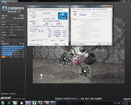- Joined
- Oct 9, 2007
- Messages
- 47,810 (7.40/day)
- Location
- Dublin, Ireland
| System Name | RBMK-1000 |
|---|---|
| Processor | AMD Ryzen 7 5700G |
| Motherboard | Gigabyte B550 AORUS Elite V2 |
| Cooling | DeepCool Gammax L240 V2 |
| Memory | 2x 16GB DDR4-3200 |
| Video Card(s) | Galax RTX 4070 Ti EX |
| Storage | Samsung 990 1TB |
| Display(s) | BenQ 1440p 60 Hz 27-inch |
| Case | Corsair Carbide 100R |
| Audio Device(s) | ASUS SupremeFX S1220A |
| Power Supply | Cooler Master MWE Gold 650W |
| Mouse | ASUS ROG Strix Impact |
| Keyboard | Gamdias Hermes E2 |
| Software | Windows 11 Pro |
Taiwanese PC enthusiast Coolaler has a new Ivy Bridge LGA1155 dual-core engineering sample to play with, and wasted no time in putting it through some tests. The sample has two cores, four threads with HyperThreading enabled, clock speed of 1.80 GHz, 256 KB L2 cache per core, and 4 MB shared L3 cache. It is running on an Intel P67 chipset-based motherboard with 8 GB of dual-channel DDR3-1600 MHz memory. At 1.80 GHz, it may not be game for absolute performance figures since it's unlikely that Intel will release a chip with that clock speed unless it has unreal performance:clockspeed gains over Sandy Bridge; but it's good enough for clock-to-clock performance comparisons between Ivy Bridge and Sandy Bridge. A Core i5-2400 was clocked at 1.80 GHz with 18x BClk multiplier, and put through a single-threaded benchmark, and a multithreaded one.
The cache and memory benchmark that measures bandwidth and latency of caches and memory was unable to measure bandwidth, but measured some latencies. The L1 cache at 2.2 nanoseconds (ns), and L2 at 2.9 ns. Next, the Ivy Bridge DC, and the Core i5-2400 (@ 1.80 GHz) testbeds were put through CPUMark 99, where Ivy Bridge DC scored 278 points, and Core i5-2400 clocked at 1.80 GHz scored closely followed at 276 points. Moving on to multithreaded performance, the two were put through Cinebench 11.5 64-bit. The Ivy Bridge DC chip scored 1.81 points; while the Core i5-2400 clocked at 1.80 GHz, scored 2.61 points. Coolaler promises more benches.





View at TechPowerUp Main Site
The cache and memory benchmark that measures bandwidth and latency of caches and memory was unable to measure bandwidth, but measured some latencies. The L1 cache at 2.2 nanoseconds (ns), and L2 at 2.9 ns. Next, the Ivy Bridge DC, and the Core i5-2400 (@ 1.80 GHz) testbeds were put through CPUMark 99, where Ivy Bridge DC scored 278 points, and Core i5-2400 clocked at 1.80 GHz scored closely followed at 276 points. Moving on to multithreaded performance, the two were put through Cinebench 11.5 64-bit. The Ivy Bridge DC chip scored 1.81 points; while the Core i5-2400 clocked at 1.80 GHz, scored 2.61 points. Coolaler promises more benches.





View at TechPowerUp Main Site
Last edited:







